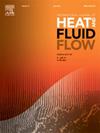Experimental study on thermal performance of a single-phase immersion cooling unit for high-density computing power data center
IF 2.6
3区 工程技术
Q2 ENGINEERING, MECHANICAL
International Journal of Heat and Fluid Flow
Pub Date : 2024-12-25
DOI:10.1016/j.ijheatfluidflow.2024.109735
引用次数: 0
Abstract
Traditional air-cooling systems cannot meet special requirements of high-density computing power data centers (DCs). The single-phase immersion cooling (SPIC) is considered as one of the best ways to effectively cool high-density computing power DC cabinets. In this study, a SPIC unit was experimentally investigated with dielectric fluid Noah 3000D under a designed heat load of 20 kW. The impact of the cooling water flow rate qv2 on the thermal characteristics, flow resistance and power consumption of the SPIC unit were investigated. The results show that the temperatures of both the coolant and cooling water decrease with the increase of qv2, but the temperature difference of coolant increases with the increase of qv2. An increase in coolant temperature difference means an increase in temperature non-uniformity. The increase in qv2 also leads to an increase in system flow resistance. In this experiment, the pressure loss of the heat exchanger and pipelines on the coolant side, account for about 56 % and 44 %, respectively. The power usage effectiveness of the cooling system in DC (cPUE) and coefficient of performance (COP) of the SPIC unit vary in the range of 1.08–1.09 and 5.69–7.21, respectively. Moreover, it is found that simply increasing qv2 cannot significantly improve the heat exchange of SPIC units, but will increase system’s energy consumption to a certain extent. The present study mainly focuses on the laboratory experimental test on the SPIC unit, and the related conclusions are significant to the design and operation of SPIC units in high-density computing power DCs.
求助全文
约1分钟内获得全文
求助全文
来源期刊

International Journal of Heat and Fluid Flow
工程技术-工程:机械
CiteScore
5.00
自引率
7.70%
发文量
131
审稿时长
33 days
期刊介绍:
The International Journal of Heat and Fluid Flow welcomes high-quality original contributions on experimental, computational, and physical aspects of convective heat transfer and fluid dynamics relevant to engineering or the environment, including multiphase and microscale flows.
Papers reporting the application of these disciplines to design and development, with emphasis on new technological fields, are also welcomed. Some of these new fields include microscale electronic and mechanical systems; medical and biological systems; and thermal and flow control in both the internal and external environment.
 求助内容:
求助内容: 应助结果提醒方式:
应助结果提醒方式:


